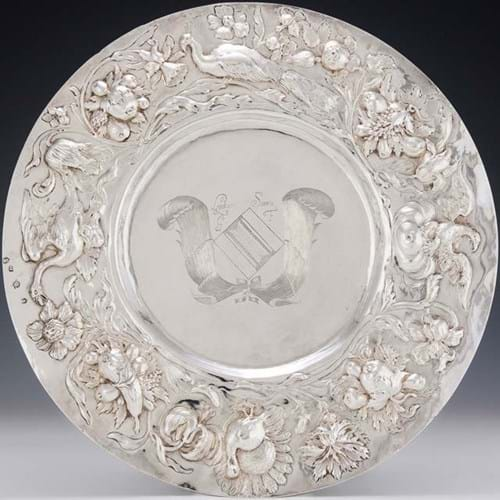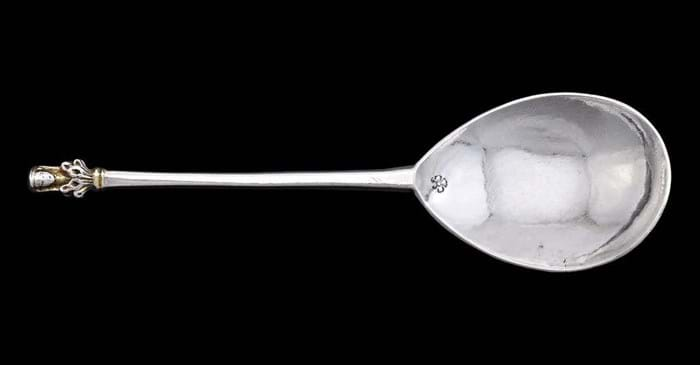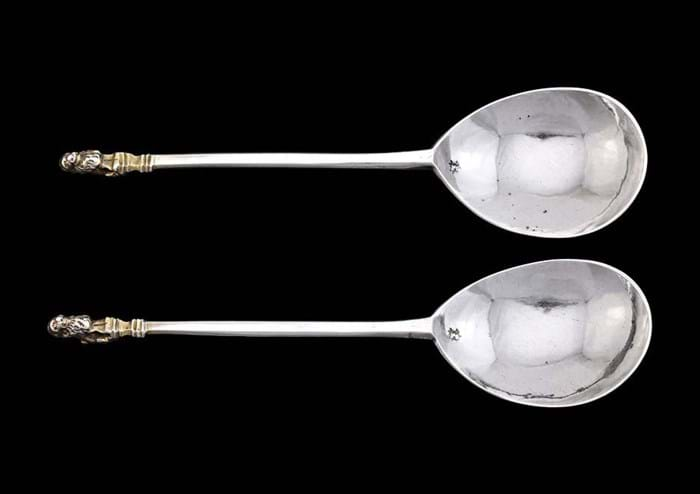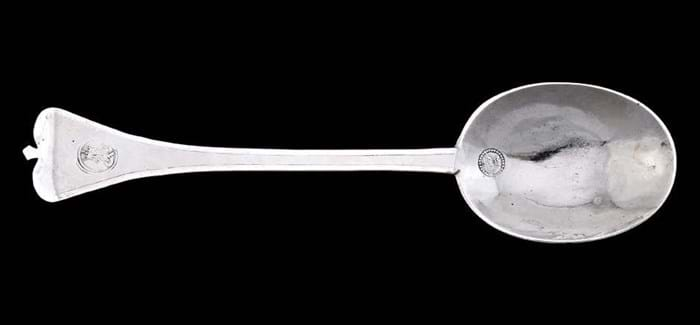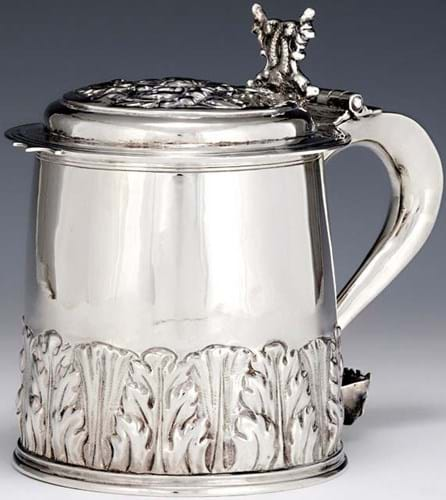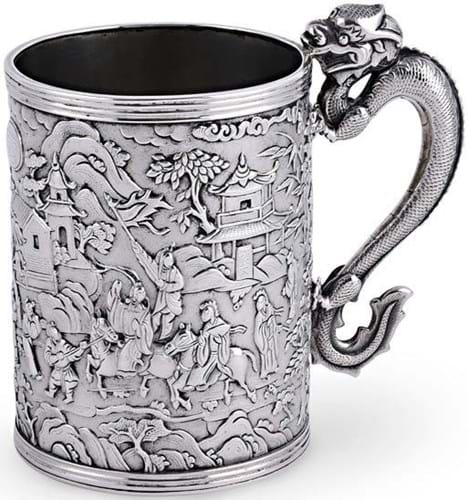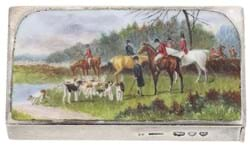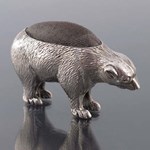The major draw for antique pieces was a private collection of Tudor, Stuart and early Georgian material assembled in the 19th and early 20th century. Stored away in the 1920s then rediscovered by the owner’s family, it was offered in 90 lots at the Newbury auction.
Estimated to bring around £150,000 at the auction on March 8-9, it sold mainly to private UK buyers and US bidders at nearly £212,000.
The stars were the two Henry VIII apostle spoons illustrated and described in ATG No 2534 (Pick of the week). They respectively doubled and tripled their estimates at £22,000 and £20,000, both going to the US.
Oldest offering
The oldest offering was a ‘maidenhead’ spoon of the type introduced in the late 14th century featuring a female bust to the finial, probably representing the Virgin Mary.
The Dreweatts example, 6¼in (16cm) long with a gilt finial, was dated to the late 15th century. It was engraved IWT to the back of the fig-shaped bowl and catalogued as provincial. Pitched at £2000-3000, it went to a US buyer at £4200 – a relatively modest sum for this form.
As befitting the interests of many Victorian antiquarians, spoons in general, and West Country spoons in particular, were a focus of the collection. Highlights included a pair of c.1580, 7in (17.5cm) long lion sejant spoons with gilt finials by Thomas Mathew of Barnstaple at £8500 and a single similar spoon dated c.1620, probably by John Quick of Barnstaple, which made £4800. Both went to UK collectors.
A rare c.1670 Royalist memento trefid spoon featured a die-struck portrait of Charles II to the stem. Measuring 8in (20cm) long and prick-engraved with initials and the date 1672, it was probably by Samuel Cawley of Exeter and was another US buy at £3800.
From further afield and much more of a surprise was a c.1695 dognose spoon by William Clerk of Glasgow which left a £100-150 estimate behind to sell to a collector at £1700.
‘Steeple’ cup
There was more than just spoons in the hoard with which to feed the market.
One of a number of stars was a rare silver-gilt ‘steeple’ cup by Anthony Bennett London, 1606, with associated Victorian cover by Robert Harper, London 1879.
The 22½in (57cm) tall cup was loaded, probably later, to stop the top-heavy piece falling over. This has been the fate of most of the 150 or so known examples which have also lost their original covers, including 12 of the 16 cups in the Kremlin.
With most of the gilding looking period and with clear marks, the Newbury cup sold to a UK collector at a mid-estimate £18,000.
Like all pre-English Civil War hollowwares, steeple cups make only rare appearances on the market.
The last examples seen at auction were the James I silver-gilt example by Thomas Francis (London 1611) sold for £75,000 as part of the David Little collection at Christie’s in 2019 and another Elizabeth I cup with the maker’s mark AB conjoined (London 1602) sold for £30,000 at Lawrences in Crewkerne in July 2021.
Another rarity was a Commonwealth salver on a conical foot. Dated London 1658, possibly by Robert Gregory, the 14½in (38cm) diameter salver had a broad flange embossed with flowers, fruit and birds and was engraved to the centre Legatum Sororis over GF and an armorial. It doubled mid-expectations, going to the US at £9500.
Best of three Georgian coffee pots in the collection was a 10in (24cm) tall Britannia standard example by Richard Bayley, London 1718.
Featuring a high domed cover with octagonal ball finial, it was engraved with a probably later armorial. The wooden double-scroll handle was a replacement and the pot had minor scratches and dents but it tripled the top estimate, going to the US at £7500.
Although wide international and UK trade interest emerged among the 900 registered bidders, UK private buyers dominated the upper end, sometimes giving way to US rivals.
Bright buys

Set of four candlesticks by Ebenezer Coker – £10,000 at Dreweatts.
Among the candlesticks in the collection was a pair of 8½in (22cm) tall Britannia standard examples by Joseph Steward, London 1719, engraved with an armorial, which tripled the mid-estimate at £7500.
A set of four 10½in (27cm) sticks with triform bases, knopped stems featuring cartouches and rocaille work by the celebrated candlestick maker John Cafe, London 1751, took £5500.
The other great name for Georgian candlesticks, Ebenezer Coker, was represented among the bulk of the silver from other sources.
Dated London 1763, Coker’s set of four 10in (25.5cm) tall shaped square sticks doubled top expectations at £10,000.
Rothschild provenance

Pair of Paul Storr krater cups – £26,000 at Dreweatts.
Other lots came for sale from Victoria Lady de Rothschild – the second of financier Sir Evelyn de Rothschild’s three wives – and a private collection assembled in the 1990s.
Names of Georgian smiths do not come greater than Paul Storr, and a pair of his silver-gilt cups from the de Rothschild collection topped the two-day sale.
Of antique krater form, the 5in (12.5cm) tall, 30oz cups were chased with flowering hop vines and featured double handles formed as entwined vines. Estimated at £6000-8000, they made £26,000.
There were opportunities to compare prices over 20 years for good-quality 18th century fare.
Despite the melt price having risen considerably across two decades (currently over £15 an ounce, it was closer to £5 an ounce in the 1990s) prices for much antique silver have changed relatively little.
A London 1672, 7in (18cm) high tapered tankard by Ralph Leeke with a flat-top cover featuring a dolphin thumbpiece and with the body half chased with an acanthus band went a little above estimate at £8500. Leeke’s work is quite rare but he was highly rated in his day and became one of nine subordinate goldsmiths to Charles II. In November 1998 the 26oz tankard had taken £8000 at Sotheby’s.
At Newbury an 8in (20cm) tall baluster beer jug by Thomas Farren, London 1742, bearing the Campbell family’s arms, also went above estimate at £6500. Weighing 29oz, it was sold at Sotheby’s in March 1997 when it took a hammer £4600.
Chinese export interest
One category that has showed significant appreciation across the past two decades is Chinese export material.
Silver from round the world featured among the de Rothschild pieces.
A mid-19th century Chinese export cylindrical mug bore the duty mark of Canton retailer and silversmith Khe Cheung. Featuring a dragon handle and chased with figures and riders in a landscape, the 4½in (11.5cm) high mug went to a Chinese buyer at £4000, five times the top estimate.


